Lilac is a decoratively flowering shrub that grows on each site. Particular beauty is manifested in the spring - during the flowering period. In order for lilacs to bloom magnificently, rejuvenation of the old bush is required, namely, pruning in the fall.
It is inexpedient to cut branches of a shrub in the spring, pruning shoots during the growing season will not bring benefit to the plant, therefore it is carried out only for urgent needs, for sanitary purposes.
Content
Why cut bushes
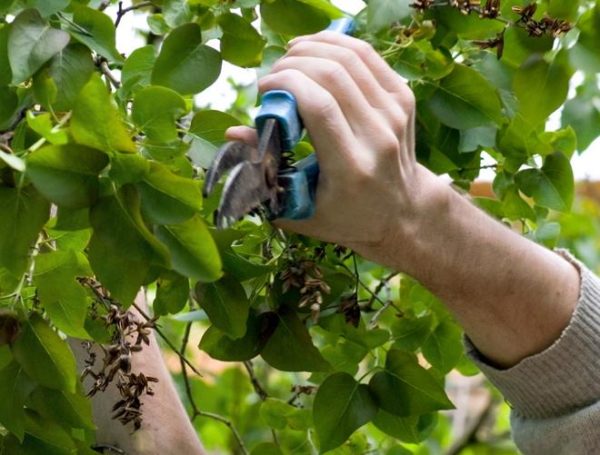 Pruning lilacs in autumn is carried out with the main goal - rejuvenation of the bush and obtaining abundant flowering in the next season. If you refuse to manipulate the bush will stretch in height, the flowers are crushed, the leaf mass will lose its saturated green color.
Pruning lilacs in autumn is carried out with the main goal - rejuvenation of the bush and obtaining abundant flowering in the next season. If you refuse to manipulate the bush will stretch in height, the flowers are crushed, the leaf mass will lose its saturated green color.
Subject to the basic rules of the manipulation, the gardener can:
- rejuvenate an existing bush;
- form a sweeping crown;
- stimulate the growth of shoots in the right direction, without thickening;
- will provide magnificent blossoming;
- will remove all damaged shoots.
In the first 2-3 years after planting a seedling, pruning is not required, because the bush grows slowly. Only a sanitary haircut is carried out, including the removal of damaged branches for the prevention of fungal diseases. In the fall, you can cut the branches into 4 pairs of leaves, for better branching.
If the gardener is waiting for flowering in the next season, you should abandon the pruning of young branches, because buds are formed on them in early spring. Removal will cause poor flowering.
How to prune in the fall
Autumn pruning - forming, is carried out in order to remove root shoots, diseased, broken stems and diseased shoots. The gardener must remember that on the eve of winter, the volume of the cut should not exceed 20% of the total above-ground mass of the plant, otherwise active growth of root shoots in autumn is possible. All young shoots will inevitably die in winter, which will cause infection of the adult bush.
Before the operation, you need to approximately create a plant layout after it. It is important to determine what the lilac should be in the garden - sprawling, compact, tall or not. To create a lush crown, you need 6-8 main shoots. If the bush is planned high, but not dense - leave 3 central. To maintain symmetry during trimming, leave smooth branches growing in different directions. Failure to comply with this rule will lead to the one-sidedness of the bush, which is very difficult to fix, the option of salvation is a total cut in winter.
In the first year after planting, all weak, crooked and damaged shoots are removed from the seedling. If a plant has two branches of the same size, growing in the same direction, one of them is cut. Branches coming from the base of the plant are shortened by a third or half length. Ideally, all shoots of the plant should be the same length.
In the fall, in the second year, the first, full haircut is carried out. The main branches do not touch. Remove shoots grown on skeletal branches, leave only strong, maintaining uniformity.Common pruning removes a third of the overgrowth. They work according to the same scheme in subsequent years until the desired crown of the bush is obtained.
Cropping patterns
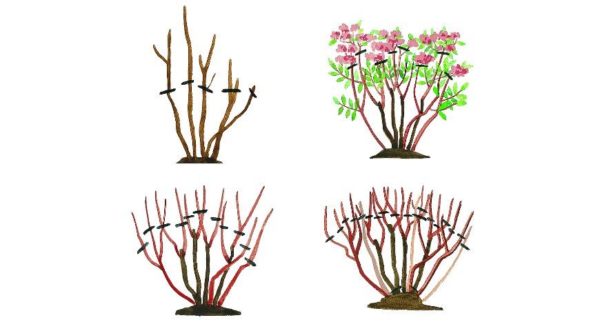 For trimming lilacs use 2 schemes. The first involves the formation of a crown, and the second - the removal of fading flowers, with the rejuvenation of the branches. Pruning of the crown in order to enhance its growth and mass gain is recommended in the spring, sacrificing flowering in the season. The largest branches are cut three times. Immediately after the formation, empty areas may appear in the crown, noticeable after the lilac blooms - this is normal.
For trimming lilacs use 2 schemes. The first involves the formation of a crown, and the second - the removal of fading flowers, with the rejuvenation of the branches. Pruning of the crown in order to enhance its growth and mass gain is recommended in the spring, sacrificing flowering in the season. The largest branches are cut three times. Immediately after the formation, empty areas may appear in the crown, noticeable after the lilac blooms - this is normal.
Inflorescence pruning is carried out immediately after flowering. It is necessary for laying flower buds for the next season. If the faded inflorescences are not removed, the bookmark will not occur and flowering will be sparse or not at all.
Necessary tools
To trim, you need:
- secateurs;
- double-sided pruning shears;
- delimbers;
- scissors;
- garden file;
- gloves
- garden knife
- soft lining under the knees.
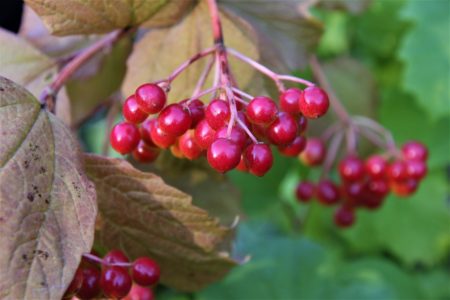 You may be interested in:
You may be interested in:When choosing tools, pay attention to:
- maximum severity;
- security;
- ease of use;
- narrowed edges of the blades;
- strength and lightness.
Before work, all tools are processed to prevent the spread of pests, bacterial, viral and fungal plants in the garden.
General rules for pruning lilacs
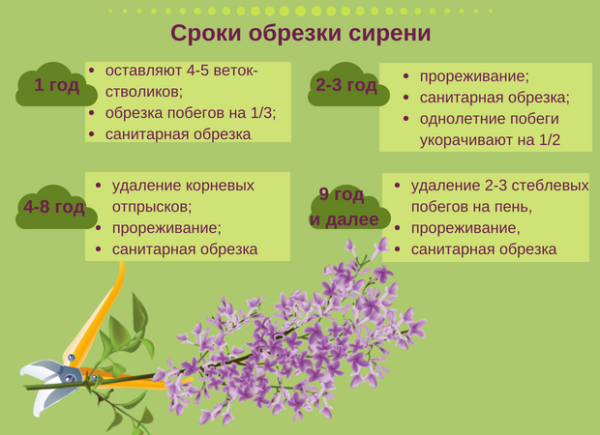 The list of basic rules and recommendations includes:
The list of basic rules and recommendations includes:
- sanitary pruning is carried out 3 times per season: in summer, spring and autumn, all damaged branches are removed;
- cutting large trunks, the cut needs to be glossed over;
- no need to straighten the crown immediately to one height, this can be done once a year, immediately after flowering;
- anti-aging pruning is performed annually;
- Regulatory haircut will allow you to get a magnificent bloom every year, for this, the skeletal branches are pruned at different levels;
- it is forbidden to break flower stalks;
- You can cut into bouquets no more than 40% of the blossoming branches, otherwise flowering will not happen next year, the plant will increase the crown and leaf mass.
Compliance with these rules will allow you to get abundant flowering on a healthy, evenly formed shrub.
How to prune lilacs
It is difficult to say clearly how to prune lilacs correctly. The technology of manipulation depends on the expected results.
Before flowering
In early spring, the bush is thinned carefully. Massive removal of branches will result in a lack of flowers in April. At this time, sanitary cleaning and thinning of the shoots is carried out. It is important to remove all broken and blackened branches, so that the appearance of the bush does not deteriorate after the growth of green leaves and an array of flowers.
During flowering
Do not be afraid to cut flowers to create bouquets - this is the main rule of lush flowering in the next season, but you should not be zealous. Removing the flowering mass may delay flowering if moderation is not respected.
When cutting flowering bouquets, an array of shrubs is thinned and young branches growing inland are removed. For slices using sharp scissors or secateurs.
After flowering
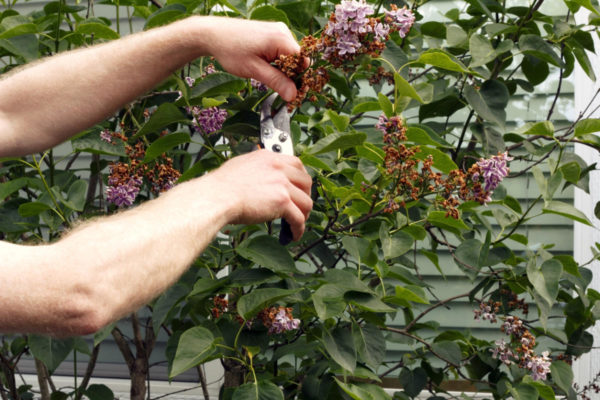 Massive pruning is carried out after flowering is completed. Manipulation requires compliance with the rules:
Massive pruning is carried out after flowering is completed. Manipulation requires compliance with the rules:
- holding immediately after flowering;
- skeletal branches and shoots are removed;
- cut off faded peduncles to prevent seed ripening.
Large sections are smeared with paint or drying oil, without this the branches can rot.
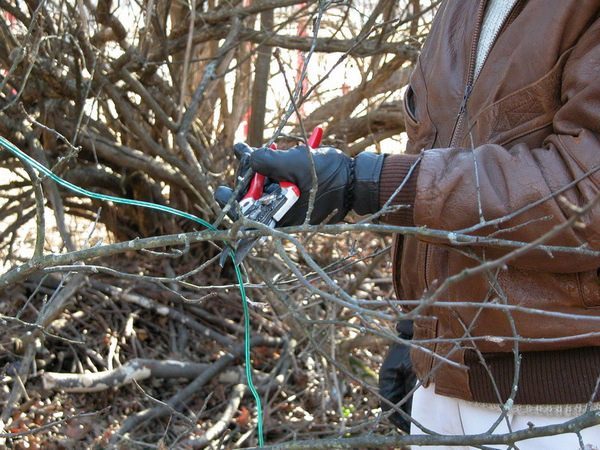 You may be interested in:
You may be interested in:Thinning bush
It is carried out in the spring. From the bush remove branches heading into its depths. Remove root shoots. It can be carried out in autumn, but until temperatures drop below 0 degrees.
Sanitary pruning
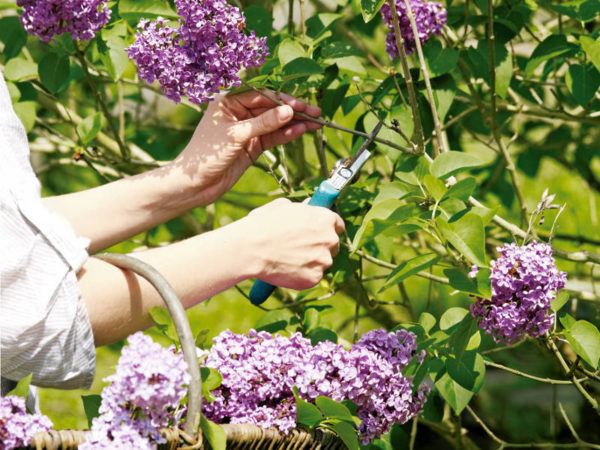 The purpose of the operation is to remove:
The purpose of the operation is to remove:
- dry, curved branches;
- competing, broken, crooked shoots;
- branches and trunks cracked from age;
- shoots, thickening the crown;
- the remainder of faded inflorescences.
Manipulation is carried out in the fall before the onset of frost. It can be carried out immediately after flowering.
Forming Cut
The formation of a lush shrub or tree with a uniform crown is a long process that requires a lot of time and effort. It takes years to get the right parameters, because cutting branches massively is to the detriment of the plant.
- Start preparing for the second year of bush growth. Leave 5 main stems. The rest are cut off at the base and cut. The top of the left branches is cut to one level.
- After a year, the branches are processed, leaving developed shoots of the upper part of the bush. Inward growth is removed along with damaged parts of the future crown.
- The crown manipulation described in this step is repeated annually.
Stamping
 Stamp pruning requires the removal of all but one of the stems. In the first year of life, pinch the seedling to a branching height, optimally 0.5-0.7 m. Next, work with the crown according to the principle of forming pruning. After leaving 4 main shoots, and then, annually thin out the shoots on them. So, continue until the desired shape, crown diameter and height.
Stamp pruning requires the removal of all but one of the stems. In the first year of life, pinch the seedling to a branching height, optimally 0.5-0.7 m. Next, work with the crown according to the principle of forming pruning. After leaving 4 main shoots, and then, annually thin out the shoots on them. So, continue until the desired shape, crown diameter and height.
Anti-aging pruning
Lilac Care Autumn often includes anti-aging treatments. They are required by overgrown shrubs. The process involves the removal of all plant trunks to a level of 15-30 cm (depending on their condition). If there is overgrowth, in anticipation of the cold weather it is removed to prevent decay. Sections are treated with drying oil. In the spring, young shoots will wake up at the bush - from them you need to grow a full-fledged bush.
When to prune lilacs: in spring or autumn
Spring manipulation has advantages, but to say that pruning is best done in spring is not possible, due to the following facts:
- the plant, due to the abundant, unnecessary mass of shoots, lacks nutrients in the winter;
- exposed to various diseases in the cold;
- won't bloom in spring.
Spring pruning is good when you need a quick set of leaf mass, in the case when the lilac is sick for a long time and can not accumulate strength. In this case, let the bush not bloom. In spring, when the plant blooms, pruning a healthy bush implies the creation of cut, bouquet compositions for home decoration.
Slicing
For processing slices, after removing large branches, I recommend using garden var. This product contains wax, vegetable oils, and rosin. Processing is required to prevent rot and infection of fungi. Garden var must be applied to the cut after pruning in the fall.
Caring for the bush after pruning
After an autumn haircut, watering is minimized, the plant is systematically prepared to lower temperatures. Excess moisture in the root system is fatal. Topping lilac autumn is not carried out. In regions with a significant decrease in temperature, the soil is mulched. The composition of the mulch will provide additional nutrition to the plant and act as fertilizer.
After trimming, the lignified part of the plant should be inspected for rot and pests. Ely disturbances are present processing is carried out before frost.
Conclusion
Everyone can grow a lush bush of lilac in a personal plot, but to form it correctly you need to make an effort. Violation of the rules will lead to the fact that the lilac bush will have to be formed from scratch. Following the instructions described, the gardener is doomed to success.
